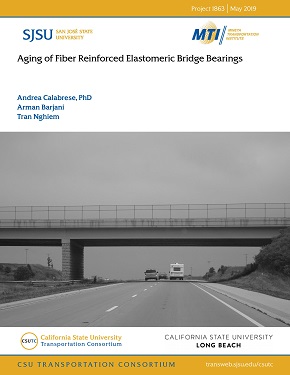- 408-924-7560
- mineta-institute@sjsu.edu
- Donate
Aging of Fiber Reinforced Elastomeric Bridge Bearings
Elastomeric bearings for thermal deformations and base isolation are used increasingly worldwide. Rubber-based devices have proven to be an effective passive protection system capable of reducing earthquake-induced forces in both the upper and the lower structures of bridges and buildings. Degradation of the bearings due to aging and environmental conditions may jeopardize their load carrying capacity, energy dissipation characteristics, and effectiveness when used as bearing pads or as base isolators. Among other environmental factors, degradation of rubber bearings is due to a variety of reasons, including, solar radiation, ozone, wind, salt water, and acid rain attacks, in addition to dynamic strain of long duration. To improve the reliability of laminated rubber bearings it is of paramount importance to understand the aging characteristics of these devices and their long-term performance both in compression and shear. While it is generally accepted that the degradation of polymers occurs as a nonuniform or heterogeneous process, detailed mechanical models including long-term degradation effects of rubber bearings used in bridges are not available. With this consideration in mind, the aim of this project is that of investigating the durability of Fiber Reinforced Bearings (FRBs) under long-term degradation, and that of assessing the modification of their axial and shear force-deformation response induced by aging effects. The study of the long-term performance of elastomeric bearings used in bridges will not only help addressing long-term road and bridge maintenance needs, but it also constitutes an invaluable contribution towards the understanding of the response of existing infrastructures under seismic loads.
ANDREA CALABRESE, PHD, ING, CENG, MICE
Dr. Calabrese joined the CSULB CECEM Department as an Assistant Professor in Fall 2017. He gained a PhD in Construction Engineering with an emphasis in Structural Engineering in 2013. He was a visiting research fellow at the Pacific Earthquake Engineering Research Center (PEER) from 2010–2012 along with having been a postdoctoral researcher of the ReLUIS Consortium at the Italian Network of University Laboratories in Earthquake Engineering, from 2013–2014. Dr. Calabrese has worked as a Structural Engineer at Foster & Partners, London and Italy for seven years. He has been a registered engineer in Italy since 2009 and a Chartered Engineer (CEng) and Full Member of the Institution of Civil Engineers (MICE) in the UK since 2017. Dr. Calabrese’s current research interests are in the fields of experimental testing, structural dynamics, base isolation, vibration engineering, and in the development of novel low-cost devices for the seismic protection of buildings. He has carried out numerous large-scale experimental studies of base isolation systems and energy-absorbing devices on the shaking table at the Department of Structural Engineering at the University of Naples in Italy. This work has been instrumental in developing low-cost seismic isolation systems using recycled rubber and flexible reinforcements for the seismic protection of buildings in developing regions.
ARMAN BARJANI
Arman Barjani is a graduate student at the CSULB CECEM Department. His responsibilities have included running the Nonlinear Response History Analyses described in this study.
TRAN NGHIEM
Tran Nghiem is an undergraduate student at the CSULB CECEM Department. His responsibilities have included performing this study’s experimental tests.
-
Contact Us
San José State University One Washington Square, San Jose, CA 95192 Phone: 408-924-7560 Email: mineta-institute@sjsu.edu






